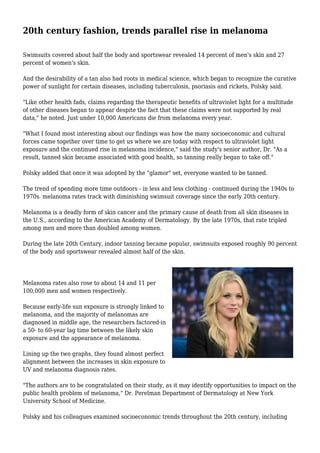
20th century fashion, trends parallel rise in melanoma
- 1. 20th century fashion, trends parallel rise in melanoma Swimsuits covered about half the body and sportswear revealed 14 percent of men's skin and 27 percent of women's skin. And the desirability of a tan also had roots in medical science, which began to recognize the curative power of sunlight for certain diseases, including tuberculosis, psoriasis and rickets, Polsky said. "Like other health fads, claims regarding the therapeutic benefits of ultraviolet light for a multitude of other diseases began to appear despite the fact that these claims were not supported by real data," he noted. Just under 10,000 Americans die from melanoma every year. "What I found most interesting about our findings was how the many socioeconomic and cultural forces came together over time to get us where we are today with respect to ultraviolet light exposure and the continued rise in melanoma incidence," said the study's senior author, Dr. "As a result, tanned skin became associated with good health, so tanning really began to take off." Polsky added that once it was adopted by the "glamor" set, everyone wanted to be tanned. The trend of spending more time outdoors - in less and less clothing - continued during the 1940s to 1970s. melanoma rates track with diminishing swimsuit coverage since the early 20th century. Melanoma is a deadly form of skin cancer and the primary cause of death from all skin diseases in the U.S., according to the American Academy of Dermatology. By the late 1970s, that rate tripled among men and more than doubled among women. During the late 20th Century, indoor tanning became popular, swimsuits exposed roughly 90 percent of the body and sportswear revealed almost half of the skin. Melanoma rates also rose to about 14 and 11 per 100,000 men and women respectively. Because early-life sun exposure is strongly linked to melanoma, and the majority of melanomas are diagnosed in middle age, the researchers factored-in a 50- to 60-year lag time between the likely skin exposure and the appearance of melanoma. Lining up the two graphs, they found almost perfect alignment between the increases in skin exposure to UV and melanoma diagnosis rates. "The authors are to be congratulated on their study, as it may identify opportunities to impact on the public health problem of melanoma," Dr. Perelman Department of Dermatology at New York University School of Medicine. Polsky and his colleagues examined socioeconomic trends throughout the 20th century, including
- 2. clothing styles, social norms, medical paradigms, economic trends and travel and vacation patterns. They divided the 20th century into four periods and reviewed the artwork, advertisements and clothing catalogues for each period. Before 1910, fair skin was desirable and there was a stigma attached to having tanned skin. "This was primarily due to the fact that most working class people worked outdoors and couldn't help but develop a tan," Polsky said in an email. "Pale skin was desirable as a sign of being a member of a wealthy, leisure class." Swimsuits covered more than 75 percent of the skin surface for both men and women and sportswear covered move than 90 percent. From 1910 to the late 1930s, tans became more acceptable. Swimsuits revealed more than 80 percent of the body and sportswear revealed about 40 percent of the body on both men and women. Skin-baring fashions, increased leisure time and acceptance of the idea of a "healthy tan" may have a lot to do with the rising numbers of new melanoma cases each year, suggests a new study. Researchers found that increasing U.S. Tanned skin was still a fashion must. It was during this time that the dangers of UV light exposure became known in medicine and sunscreens were recommended by dermatologists to avoid sunburn.
- 3. In 1950, about 3 people in every 100,000 were diagnosed with melanoma. David Polsky. "In this country, the medical profession is clearly limited in how much it can influence people's attitudes about the potential dangers that result from achieving a tan," said Polsky, a dermatologist with the Ronald O. The average American had more leisure time to spend outdoors and clothing became a little more revealing. Mark Albertini told Reuters Health in an email. "People need to avoid tanning centers, be thoughtful about their sun exposure, and use sun blocks as well as sun protective clothing," said Albertini, a cancer specialist with the University of Wisconsin in Madison who was not involved in the study. It's important to emphasize that early detection and surgical removal remain the cornerstones of care for melanoma, he added. The new study doesn't prove that fashion trends caused a rise in melanoma, but the trends "provide a historical framework for the changing attitudes promoting increased UV exposure and the rising incidence of melanoma throughout the past century," the authors write in the American Journal of Public Health. On a hopeful note, the study team points out that melanoma rates began declining in Australia after public health campaigns reduced the desire to tan. And just as celebrities played a role in popularizing tanned skin long ago, Polsky told Reuters Health, changing the attitudes of the general public will require more celebrities and fashion leaders to take the lead and make tanned skin unfashionable.